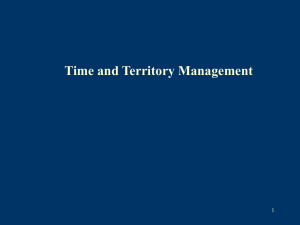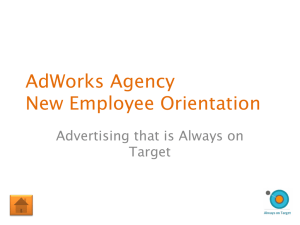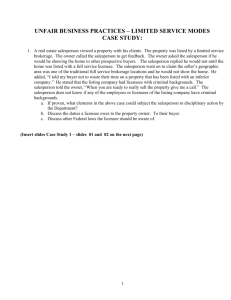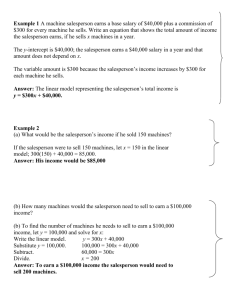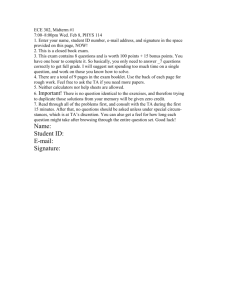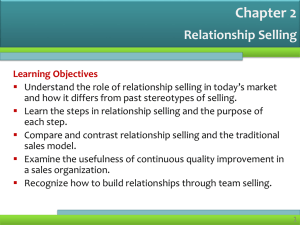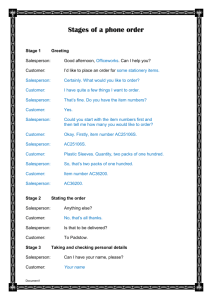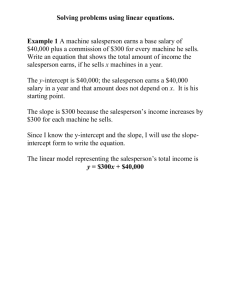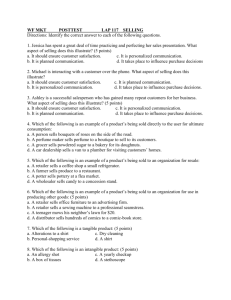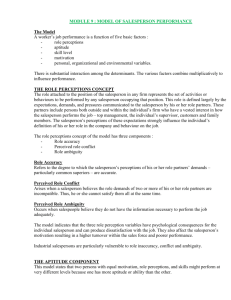How to Use and Interpret the Salesperson Development Report (SDR)
advertisement
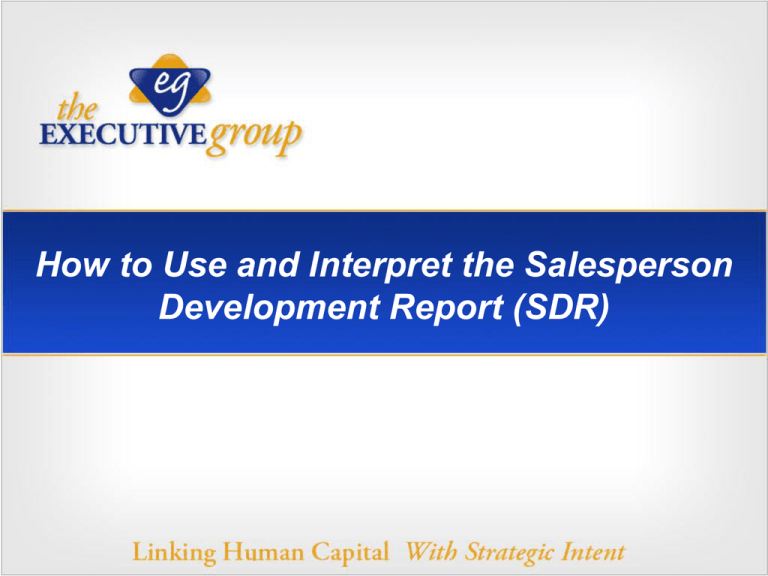
How to Use and Interpret the Salesperson Development Report (SDR) One of the biggest challenges facing sales managers is how to increase sales force effectiveness. The Goal: SALES EXCELLENCE Sales Excellence Strategic Transformation Vision Strategy Innovation Creativity Sales Leadership Alignment Inclusion Energy Motivation Coaching Direction Collaboration Emotional Intelligence Personal Competence Self Awareness Self Management Social Competence Social Awareness Relationship Management Skills & Abilities Thinking Skills Sales Skills Product/Industry Knowledge Account Management and Account Development Environment Corporate Culture Values Customers Area Objectives Competition Identifying “Gifts” and “Limits” There are certain competencies that are necessary for an individual to live by and lead by. Identifying what those competencies are helps you to manage your sales force to a set of common objectives. Tools for managing your sales force Salesperson Development Report (SDR) Sales Competency Inventory Sales Development Action Plan 3- Color Exercise SWOT Analysis Purpose of the Salesperson Development Report Use the SDR as a way to help your salesperson reflect on his/her style of relating with others as you work towards your sales goals. Sales Development Report This comprehensive report assesses behavioral characteristics and abilities related to sales success. It provides insight into a person’s own style and how these behaviors impact the sales process. Dimensions include 7 key areas of sales competencies: Problem-solving ability Durability and resilience Social skills Drive Friendliness Intuition Follow-through How to use the Salesperson Development Report Have your salesperson thoroughly read their Salesperson Development Report and complete the exercises including: Personal Development Process Setting Your MISSION Taking a PERSONAL INTERVIEW Identifying LEARNING PATHWAYS Taking ACTION Evaluating RESULTS Personal Development Process© Setting the Mission To reach the desired outcome, you must set the mission. Identify & put in writing specific strategies and tactics to achievement Sales Competency Inventory Have your salesperson complete the Sales Competency Inventory Sales Skills Dimensions measured by the Sales Competency Inventory Prospecting Skills Telephone Skills Presentation Skills Handling Objections Closing Skills Organization Follow Through Time Management Territory Management Account Management Customer Retention Analytic/Learning Creative Ability Business Acumen Social Interpersonal Aggressive / Driven Motivation Team Work/Independence Conscientiousness Communication Emotional Quotient Sales Development Action Plan Have your salesperson complete the Sales Development Action Plan: 3-color exercise SWOT Analysis Development Plan Self Awareness How deep is it? Blind Spots The difference between “Self Awareness” and a person’s “Accurate Self Assessment” may not be one in the same. So how accurate is it? Self-Insight A strength overused . . . may become a weakness. The problem is most people don’t have enough self-insight! Understanding Personal Motivation 1. 2. 3. 4. 5. Goals Fears Motivators Needs Values Self Awareness Self Management Personal Competence Self Development Personal Accountability Self Management Learning to create a Personal Vision What will you learn about yourself? How will you monitor yourself? What new skills and abilities do you want to acquire? What goals do you have for yourself? What will you commit to for your development? How will you clarify your vision? How will you devote your time and effort? Components of Sales Success Motivation Boundaries Style Ability Experience Drive Morals Personality Ability Lessons Learned Purpose Integrity Openness Vision Willingness Salesperson Development Report Three Color Exercise Sets the stage for learning Sets the conditions for discussion Helps establish the ground rules How you see your strengths Things you disagree with Areas you see you could improve in Sensitivity to Feedback Defensive Embarrassed by results Concerned regarding accuracy of feedback How it will be used * No trait is good or bad. It is the context that defines a trait’s effectiveness Basic Components Enhances Self-awareness For development only Personality paradoxes Unique vs. common traits Trait – impact on role Personality and sales success Dimensions Measured in the SDR Problem Solving Social Skills Friendliness Follow Through Durability and Resilience Drive Intuition Problem Solving – Factor B Concrete Thinking (-) Prefers simple Could experience difficulty handling abstract problems May make poorer judgments or slower decision making Experiences blind spots Sticks with simple version, likes familiar, likes repetition Abstract Reasoning (+) Prefers complex approach Insightful, fast learning, intellectually adaptable Inclined to use better judgment, decision making Makes mental leaps Synthesizes new concepts from previous applications Social Skills Introverted(-) F Serious, somber H Shy, quiet Q1 Prefers the familiar Extraverted (+) Enthusiastic, lively Bold, adventurous Open to new exploration Friendliness Introverted A Reserved, distant, less engaging (-) N Indirect, private (+) Q2 Self-sufficient, independent (+) Extraverted Warm, receptive, expressive (+) Forthright, selfdisclosing (-) Group-oriented, collaborative (-) Follow Through Spontaneous G Expedient, unconventional (-) Q3 Impulsive, less orderly (-) M Focused on ideas (+) Self-Controlled Rule-conscious, conventional (+) Meticulous, more orderly (+) Focused on solutions (-) Durability & Resilience Stress Prone C L O Q4 I Emotional, easily upset (-) Vigilant, blaming (+) Apprehensive (+) Tense, driven (+) More sensitive/less resilient (+) Resilient Calm, adaptive (+) Trusting, accepting (-) Composed, adaptable (-) Relaxed, calm (-) More calm/thick-skinned (-) Drive Accommodating E Adaptive, more patient (-) L Trusting (-) Q1 Conservative (-) H Low ego strength (-) Drive / Influencing Assertive, more dominant (+) Skeptical (+) Experimenting (+) High ego strength (+) Intuition Receptive H Social boldness (+) Sensitive to people, I ideas (+) M Imaginative (+) Q1 Experimenting (+) Practical Shy and reserved (-) More in tune with practical things (-) Grounded (-) Conservative (-) Individual Development Action Plan 3 Color exercise Identify strengths, weaknesses, opportunities and threats (SWOT) Write objectives Specify resources and strategies Identify with stakeholders Make a timeline Network for support Give evidence of accomplishment Review progress with stakeholders Review in 6 months Developing Personal Competence The more you learn about you, the more acutely aware you become, of your own ignorance. Peter Senge, author The Fifth Discipline
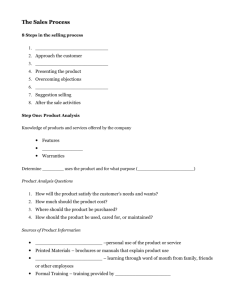

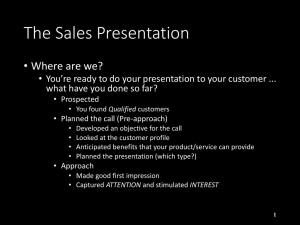

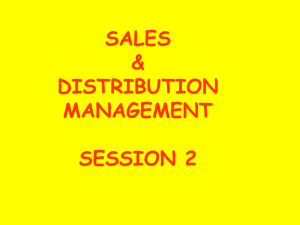
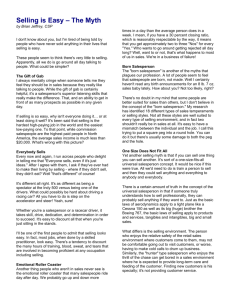
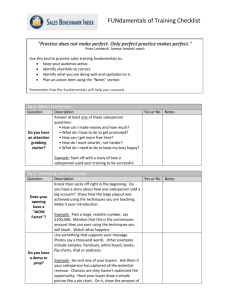
![Payment Protection Insurance - sample complaints letter [ 34 kb]](http://s3.studylib.net/store/data/007389999_1-805d992d8bb2c2dea2c669c2f61a82aa-300x300.png)
